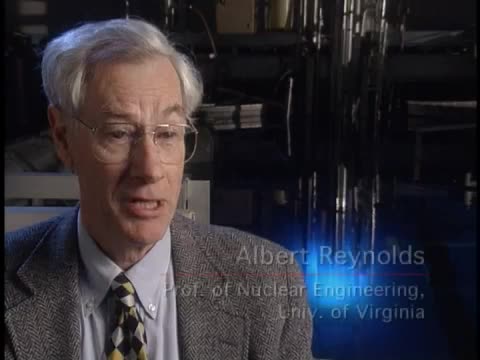Teachers' Domain; Physical Science/Engineering; Nuclear Reaction: Fission

- Transcript
In July of 1945 the United States Army assembled some of the world's greatest physicists in the New Mexican desert at Los Alamos. Armed with an understanding of Chain Reaction and Einstein's famous phenomenon equals MC squared. The goal was to create an atomic bomb before the enemy. In a short time scientific theories were turned into something of enormous power. When the United States dropped nuclear bombs on Hiroshima and Nagasaki. More than 100000 people were killed in Hiroshima alone. The atomic age had begun. After the war scientists hope to use nuclear power at home. This time harnessing the power of the nucleus for cheap clean energy. By nine hundred
fifty one scientists and engineers had taken the same technology that destroyed Hiroshima and Nagasaki and used it to generate electricity. There was a very exciting field we thought it would be the leading method of making electricity throughout the world. You have a very small amount of space 12 feet tall to 12 feet in diameter and you produce enough electricity to run a large city in that small space. So the energy source is extremely concentrated which is one of its great benefits. The principal element used in nuclear fission is uranium 235 before the war. Scientists discovered a special property of this particular isotope of uranium. When a neutron strikes the nucleus of U-235. It causes the atom to fission or split releasing more neutrons that can split other uranium atoms. Each fission releases large amounts of energy.
By making small pellets containing uranium 235. Loading them into fuel rods and putting them into the nuclear core. Scientists are able to create a self-sustaining chain reaction that produces enormous amounts of energy. This energy is used to heat water. Which produces steam that drives turbines generating electricity. 20 percent of the electricity consumed in the United States now comes from nuclear power. But debate continues about plant safety and the risks associated with transporting and storing nuclear waste.
- Series
- Teachers' Domain
- Program
- Physical Science/Engineering
- Producing Organization
- WGBH Educational Foundation
- Contributing Organization
- WGBH (Boston, Massachusetts)
- AAPB ID
- cpb-aacip/15-kk9474705h
If you have more information about this item than what is given here, or if you have concerns about this record, we want to know! Contact us, indicating the AAPB ID (cpb-aacip/15-kk9474705h).
- Description
- Episode Description
- Splitting a uranium atom creates an enormous amount of energy. This video segment adapted from Frontline: Nuclear Reaction looks at nuclear fission.
- Description
- This video segment adapted from FRONTLINE looks at nuclear fission as an energy source that can be used to generate electricity.
- Description
- See related asset "phy03_vid_fission_Backgrounder.xml"
- Description
- What is the principal element used in nuclear fission? What special property does it have? How are the products of the fission of U-235 transformed into household energy such as electricity? Why do you think nuclear power is a controversial energy source?
- Description
- This video segment adapted from FRONTLINE introduces the research that led to the first atomic bomb and, later, to nuclear energy production. The narration details why, when the nuclei of a particular isotope of uranium (U-235) are split, enormous amounts of energy are released that can be used to generate electricity.
- Topics
- Science
- Subjects
- None; None; motion :: elastic/inelastic collision; science; Energy and Power Technologies; Energy Sources; The Atomic Basis of the Properties of Matter; Atomic Nucleus; energy :: type :: nuclear; matter :: component parts :: atom :: nucleus :: neutron :: isotope; energy :: matter :: E=mc2; physical property :: charge; physical property :: charge; physical property :: mass; research :: science and society :: history; structure and properties of matter :: atoms :: isotopes of elements; structure and properties of matter :: nuclear chemistry :: fission; structure and properties of matter :: nuclear chemistry :: effects of radiation; thermodynamics :: heat; wave :: type :: electromagnetic; matter :: change :: nuclear :: fission
- Rights
- Rights Note:Download and Share,Rights:,Rights Credit:1997 WGBH Educational Foundation. All rights reserved. A FRONTLINE coproduction with the Palfreman Film Group, Inc. Footage courtesy of National Archives & Universal News and U.S. Department of Energy, Argonne National Lab.,Rights Type:All,Rights Coverage:,Rights Holder:WGBH Educational Foundation
- Media type
- Moving Image
- Duration
- 00:02:54
- Credits
-
-
Producing Organization: WGBH Educational Foundation
Publisher: Teachers' Domain
- AAPB Contributor Holdings
-
WGBH
Identifier: 53313ecfc2521fa43bb29bba584dca8d8ec837aa (ArtesiaDAM UOI_ID)
Format: video/quicktime
Color: Color
Duration: 00:00:00
If you have a copy of this asset and would like us to add it to our catalog, please contact us.
- Citations
- Chicago: “Teachers' Domain; Physical Science/Engineering; Nuclear Reaction: Fission,” WGBH, American Archive of Public Broadcasting (GBH and the Library of Congress), Boston, MA and Washington, DC, accessed July 22, 2025, http://americanarchive.org/catalog/cpb-aacip-15-kk9474705h.
- MLA: “Teachers' Domain; Physical Science/Engineering; Nuclear Reaction: Fission.” WGBH, American Archive of Public Broadcasting (GBH and the Library of Congress), Boston, MA and Washington, DC. Web. July 22, 2025. <http://americanarchive.org/catalog/cpb-aacip-15-kk9474705h>.
- APA: Teachers' Domain; Physical Science/Engineering; Nuclear Reaction: Fission. Boston, MA: WGBH, American Archive of Public Broadcasting (GBH and the Library of Congress), Boston, MA and Washington, DC. Retrieved from http://americanarchive.org/catalog/cpb-aacip-15-kk9474705h